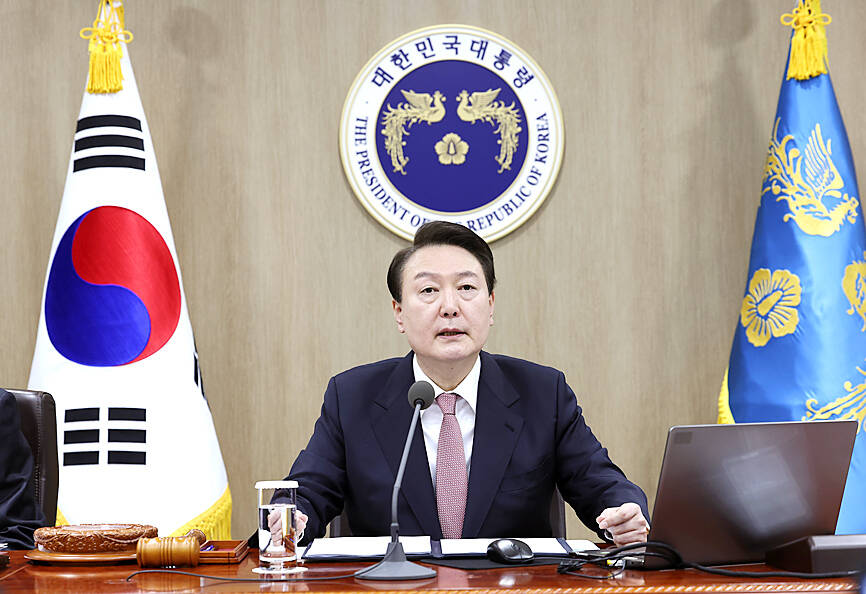South Korea yesterday revised down its 2030 targets for reducing greenhouse gas emissions in the industrial sector, but maintained its national goal of cutting emissions by 40 percent of 2018 levels in what it called a reasonable adjustment.
This is the first annual and sectoral emissions reduction targets put forward by South Korean President Yoon Suk-yeol.
South Korea has sought to reach carbon neutrality by 2050.

Photo: AP
Under the plan, the industrial sector would be required to cut emissions by 11.4 percent from the 2018 levels by 2030, compared to 14.5 percent set in late 2021, the Presidential Commission on Carbon Neutrality and Green Growth said.
The gap would be filled by switching more energy sources to renewables and making more reductions overseas, it said.
The country aims to use less carbon-intensive energy sources to reduce emissions by 45.9 percent from 2018 levels by 2030, up from the existing target of 44.4 percent.
“We’ve eased industrial reduction targets in light of realistic domestic conditions including raw material supply and technology prospects,” the commission said in a statement.
“In the energy sector, the target was raised to further reduce greenhouse gases through a balanced energy mix between nuclear power and renewables, and by accelerating the shift to clean energy such as solar and hydrogen,” it said.
As part of the efforts, South Korea plans to boost nuclear energy to 32.4 percent of total power production by 2030, up from 27.4 percent in 2021, and renewables to at least 21.6 percent of power output from 7.5 percent, the commission said.
Yoon, who took office in May last year, has scrapped his predecessor’s drive to phase out nuclear energy and pledged to expand it to more than 30 percent of the energy mix.
South Korea supplies more than 40 percent of its electricity from coal and has vowed to halve the portion by 2030, but environmental groups have said that the goals are too low and criticized its plans to build more coal-fired plants.

To many, Tatu City on the outskirts of Nairobi looks like a success. The first city entirely built by a private company to be operational in east Africa, with about 25,000 people living and working there, it accounts for about two-thirds of all foreign investment in Kenya. Its low-tax status has attracted more than 100 businesses including Heineken, coffee brand Dormans, and the biggest call-center and cold-chain transport firms in the region. However, to some local politicians, Tatu City has looked more like a target for extortion. A parade of governors have demanded land worth millions of dollars in exchange

Hong Kong authorities ramped up sales of the local dollar as the greenback’s slide threatened the foreign-exchange peg. The Hong Kong Monetary Authority (HKMA) sold a record HK$60.5 billion (US$7.8 billion) of the city’s currency, according to an alert sent on its Bloomberg page yesterday in Asia, after it tested the upper end of its trading band. That added to the HK$56.1 billion of sales versus the greenback since Friday. The rapid intervention signals efforts from the city’s authorities to limit the local currency’s moves within its HK$7.75 to HK$7.85 per US dollar trading band. Heavy sales of the local dollar by

Taiwan Semiconductor Manufacturing Co’s (TSMC, 台積電) revenue jumped 48 percent last month, underscoring how electronics firms scrambled to acquire essential components before global tariffs took effect. The main chipmaker for Apple Inc and Nvidia Corp reported monthly sales of NT$349.6 billion (US$11.6 billion). That compares with the average analysts’ estimate for a 38 percent rise in second-quarter revenue. US President Donald Trump’s trade war is prompting economists to retool GDP forecasts worldwide, casting doubt over the outlook for everything from iPhone demand to computing and datacenter construction. However, TSMC — a barometer for global tech spending given its central role in the

An Indonesian animated movie is smashing regional box office records and could be set for wider success as it prepares to open beyond the Southeast Asian archipelago’s silver screens. Jumbo — a film based on the adventures of main character, Don, a large orphaned Indonesian boy facing bullying at school — last month became the highest-grossing Southeast Asian animated film, raking in more than US$8 million. Released at the end of March to coincide with the Eid holidays after the Islamic fasting month of Ramadan, the movie has hit 8 million ticket sales, the third-highest in Indonesian cinema history, Film